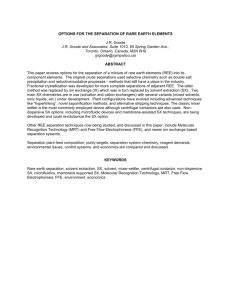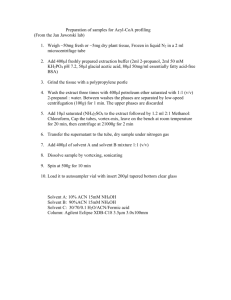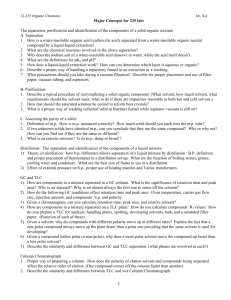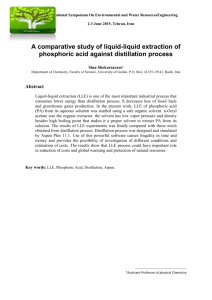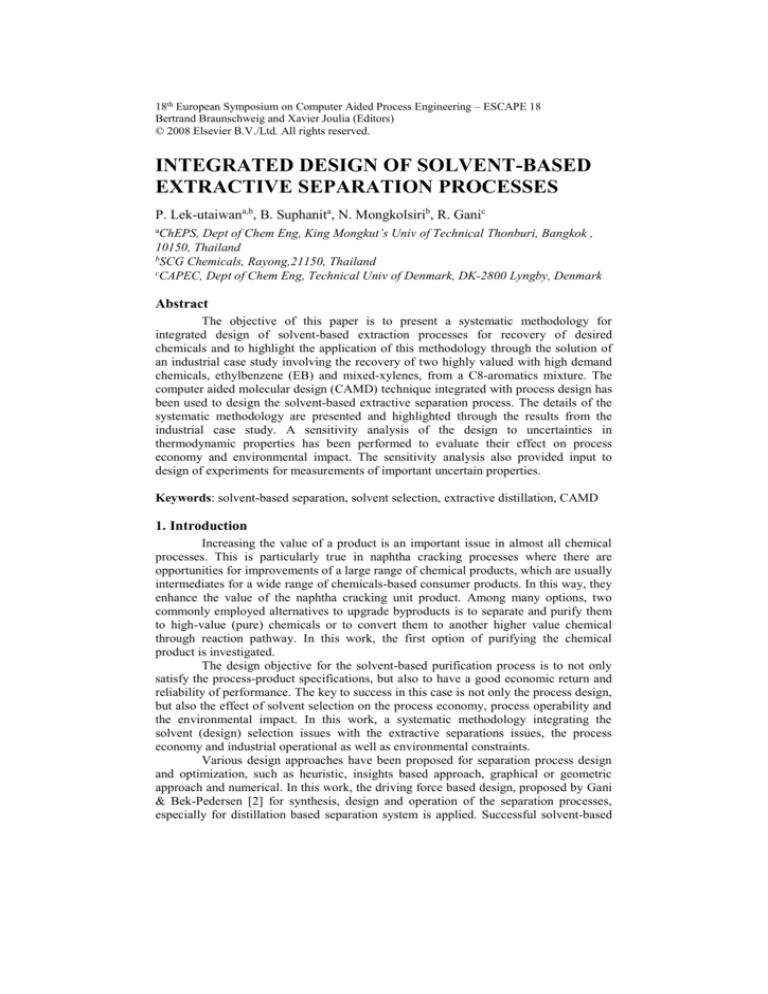
18th European Symposium on Computer Aided Process Engineering – ESCAPE 18
Bertrand Braunschweig and Xavier Joulia (Editors)
© 2008 Elsevier B.V./Ltd. All rights reserved.
INTEGRATED DESIGN OF SOLVENT-BASED
EXTRACTIVE SEPARATION PROCESSES
P. Lek-utaiwana,b, B. Suphanita, N. Mongkolsirib, R. Ganic
ChEPS, Dept of Chem Eng, King Mongkut’s Univ of Technical Thonburi, Bangkok ,
10150, Thailand
b
SCG Chemicals, Rayong,21150, Thailand
c
CAPEC, Dept of Chem Eng, Technical Univ of Denmark, DK-2800 Lyngby, Denmark
a
Abstract
The objective of this paper is to present a systematic methodology for
integrated design of solvent-based extraction processes for recovery of desired
chemicals and to highlight the application of this methodology through the solution of
an industrial case study involving the recovery of two highly valued with high demand
chemicals, ethylbenzene (EB) and mixed-xylenes, from a C8-aromatics mixture. The
computer aided molecular design (CAMD) technique integrated with process design has
been used to design the solvent-based extractive separation process. The details of the
systematic methodology are presented and highlighted through the results from the
industrial case study. A sensitivity analysis of the design to uncertainties in
thermodynamic properties has been performed to evaluate their effect on process
economy and environmental impact. The sensitivity analysis also provided input to
design of experiments for measurements of important uncertain properties.
Keywords: solvent-based separation, solvent selection, extractive distillation, CAMD
1. Introduction
Increasing the value of a product is an important issue in almost all chemical
processes. This is particularly true in naphtha cracking processes where there are
opportunities for improvements of a large range of chemical products, which are usually
intermediates for a wide range of chemicals-based consumer products. In this way, they
enhance the value of the naphtha cracking unit product. Among many options, two
commonly employed alternatives to upgrade byproducts is to separate and purify them
to high-value (pure) chemicals or to convert them to another higher value chemical
through reaction pathway. In this work, the first option of purifying the chemical
product is investigated.
The design objective for the solvent-based purification process is to not only
satisfy the process-product specifications, but also to have a good economic return and
reliability of performance. The key to success in this case is not only the process design,
but also the effect of solvent selection on the process economy, process operability and
the environmental impact. In this work, a systematic methodology integrating the
solvent (design) selection issues with the extractive separations issues, the process
economy and industrial operational as well as environmental constraints.
Various design approaches have been proposed for separation process design
and optimization, such as heuristic, insights based approach, graphical or geometric
approach and numerical. In this work, the driving force based design, proposed by Gani
& Bek-Pedersen [2] for synthesis, design and operation of the separation processes,
especially for distillation based separation system is applied. Successful solvent-based
2
P. Lek-utaiwan et.al.
extraction system design also requires the use of a good (environmentally acceptable)
solvent that can increase driving force of interesting key components.
2. Methodology for design of solvent-based extraction processes
The systematic methodology integrates the solvent design (selection) issues
with the extractive separation issues, the process economy and industrial operational as
well as environmental constraints. The CAMD technique [1] is combined with analysis
of residue curve maps and separation driving forces to generate feasible solvent-based
extractive separation process flow-diagrams. The best process is identified as the one
that satisfies all the product-process constraints as well as being economic and
environmentally acceptable. Figure 1 shows the main steps of the systematic
methodology.
Figure 1: Block diagram of the integrated design of solvent-based separation process sequencing
algorithm
The methodology highlighted in Fig 1 employs a number of computer aided
methods & tools. For solvent selection, it employs the ProCAMD software [4] that
designs/selects solvents for specified solvent target properties. The solvent (entrainer)
plus the binary mixtures to be separated forms ternary systems whose distillation
boundaries and residue curve maps are analyzed to identify the suitable solvent. ICASPDS is used for this purpose. As the solvent-based ternary systems are non-ideal
mixtures, the accuracy of the predicted vapor-liquid phase equilibria are verified, where
possible, with available experimental data and compared with more than one property
model. In this case, the following software, ICAS®, Aspen Plus®, Aspen Distill®, or
DistillDesigner® have been used. For solvent recovery column design, the driving force
Integrated design of solvent-based extractive separation process
3
approach of Gani and Bek-Pedersen [2] has been used while for the two-feed extractive
distillation column, the method proposed by Petlyuk [3] has been used. For a feasible
process configuration, the operational costs as well as the equipment costs are
calculated to obtain the final economic analysis. The type of solvent used and its loss
with the products provides an account of the environmental impact. In a business
(industrial) world, the most important issue is not just operational feasibility but also
economic feasibility. Therefore, an economic evaluation is needed before any new
process investment can be made. However, before any such investments, any
uncertainties in the design need to be quantified. Therefore, a sensitivity analysis of the
uncertain parameters to investigate the effects on process economy is performed as the
last task of the systematic design methodology. The conclusions of the sensitivity
analysis helps the engineers to decide if further experimental work is necessary.
3. Industrial case study
This case study involves the recovery of highly valued and high demand
ethylbenzene (EB) and mixed-xylenes (comprising of p-xylene (PX), m-xylene (MX)
and o-xylene (OX)) from a C8-aromatics mixture (C8A). As point out above, C8A is
isomers mixture, so their separation (recovery) is not simple, that why there is only one
commercial process of liquid-phase adsorptive separation available for EB recovery
from C8A. [8] However, this process requires high investment cost and generates huge
volume of waste adsorbent that may become an environmental problem. Therefore,
another green process should be considered for the EB purification. The ratio of various
properties of the key components (EB and PX) were tested to examine the possibly
alternatives. The result showed, by vapor pressure ratio, the solvent-based extractive
distillation can be employed for their purification. [7]
3.1. Solvent selection
The problem of identifying solvents for the separation of EB from PX by
extractive distillation is considered first. The target solvent properties are solubility
parameter, the normal boiling point, the normal melting point and selectivity (Sij =
i/j). Specifying the above constraints to ProCAMD, a list of feasible solvents were
obtained, from which, a selection is listed in Table 1.
Table 1 Selected solvent by ProCAMD
Result
no
1
2
3
4
5
6
7
8
9
Solvent Name
Solubility
parameter
at 298 K
(MPa1/2)
Normal
Melting
point
(K)
Normal
Boiling
point
(K)
Selectivity
Aromatic-Aldehyde-1 (AAD1)
Acyclic-Ester-1 (AE1)
Cyclic-Ketone-1 (CK1)
Acyclic-Ester-2 (AE2)
Acyclic-Ketone-1 (AK1)
Cyclic-Ketone-2 (CK2)
Acyclic-Ketone-2 (AK2)
Aromatic-Alcohol-1 (AAL1)
Cyclic-Amide-1 (CAD1)
21.44
21.42
17.86
19.84
17.69
19.88
17.88
24.09
23.16
247.15
254.15
265.05
234.15
209.23
244.91
232.4
248.81
249.15
453.51
475.15
488.35
453.95
422.02
419.32
451.08
466.67
475.15
1.23
1.22
1.22
1.20
1.19
1.19
1.18
1.13
1.13
4
P. Lek-utaiwan et.al.
As result in table 1, the solvent that claimed by Berg’s patent [7] was also
presented in the list at the fifth rank. This means successful in solvent selection could be
achieved because the better solvents in term of both selectivity and solvent recovery
can be acquired. (Berg’s solvent has closed boiling point to OX, so this becomes solvent
recovery problem.) Due to its concentration-independent, the selectivity is the primary
criterion chosen to be considered for selecting the suitable solvent in stead of the driving
force. However, the selection of the best solvent based on only S ij is inadequate because
it does not directly relate to the distillation design. The suitable criterion should return
to how significant the solvent could alter the driving force between the key components.
3.2. Analysis of the solvents in terms of driving force diagrams
The performance of the solvents were checked through solvent-free driving
force diagrams for different choices of the property models. Figure 2 shows the solventfree driving forces obtained for the same systems with the original UNIFAC-VLE
model and the UNIFAC-Do model [5]. As solvent AE1 (acyclic-ester-1) appears to
have desired predicted behavior with both models, it is selected for further studies.
One important point of difference is the predicted values of Dy (see Figures 2a-2b).
With the UNIFAC-VLE model, it is 0.045 while with UNIFAC-Do, it is 0.145.
Therefore, experimental verification is necessary to establish the true value and a
sensitivity analysis to determine the solvent property effects on process economy needs
to be checked before a decision for pilot plant studies can be made.
Diving force curve-UNIFAC-DMD
Diving force curve-UNIFAC
0.16
0.06
No-Solvent
AAD1
AE1
CK1
AE2
AK2
CAD1
AK1
CK2
AAL1
0.05
0.04
No-Solvent
AAD1
AE1
CK1
AE2
AK2
CAD1
AK1
CK2
AAL1
0.14
0.12
0.1
DF
DF
0.08
0.03
0.06
0.02
0.04
0.02
0.01
0
0
0.1
0.2
0.3
0.4
0.5
0.6
0.7
0.8
0.9
1
0
0
0.1
0.2
0.3
0.4
0.5
0.6
0.7
0.8
0.9
1
-0.02
xEB
(a) by UNIFAC
xEB
(b) by UNIFAC-Do
Figure 2: Solvent-free driving force curves plots for selected solvents
Assuming that one of the models is correct, the design calculations can be
continued to obtain the process economic analysis. At the same time, the environmental
impact can also be investigated. As our selected solvent is an ester, it’s MSDS shows
low human effect, which may only act as an irritant to skin, eye and respiratory, and do
not have any other environmental effect. So, it can be concluded that solvent is suitable
for separation of EB from PX by extractive distillation.
3.3. Process design
Solvent-based separation through extractive distillation consists of two
distillations. The first is an extraction column with two feed (Aspen Distill® was used
designing this column), while the second is a simple distillation column (the driving
force concept was used for designing this column). The design was then verified by
rigorous simulation using Aspen Plus®. The residue curve map (see Fig. 3) was used
Integrated design of solvent-based extractive separation process
5
for the design of the first column to have consistent bottom and top products. The
design details for this column for both models are given in Table 2.
For the solvent recovery column, fifty theoretical stages were required for total
recovery the solvent with degree of purity to level of 99.99%mol. Key components for
this column were AE1 and OX. By driving force concept, at Dx = 0.4, the feed location
was at 30th stage. The conventional distillation for separating EB to the required purity
was also designed to compare with the extractive distillation approach. Since C8
aromatics mixture is an ideal mixture, so the same results were obtained from both
property packages [6], which total number of stage was 298 stages, feed location was at
179th stage (Dx = 0.4, Dy = 0.0145), reflux ratio was 20, reboil ratio was 23.3.
Separation of EB by a single conventional distillation column is obviously not feasible.
However, the data can be used to compare with extractive distillation system in terms of
investment cost and operating cost.
AE1
AE1
(a) Feed and products specifications
(b) Complete design
Figure 3 Residue curve maps of EB-PX-AE1 system
Table 2 Input data and results from Aspen Distill® for extraction column design
Input
Parameter
Value
EB/PX mix.
rate
EB/PX mix.
composition
AE1 rate
1.0
AE1
composition
Distillate
composition
AE1 = 1.0
Bottom
product
compositon
Reflux ratio
Operating
pressure
EB = 0.6
PX = 0.4
2.5
EB = 0.995
PX = 0.005
AE1 = 1e-6
EB = 0.031
PX = 0.121
AE1 = 0.848
20
1 atm
UNIFAC
Output Parameters
Number of
theoretical stages
Feed location
UNIFAC-Do
Value
78
Output Parameters
Number of
theoretical stages
Feed location
Value
44
EB/PX mix.
stream
AE1 stream
33th
0.53
Distillate product
rate
0.53
Bottom product
rate
0.47
Bottom product
rate
0.47
Reboil ratio
2.20
Reboil ratio
2.52
EB/PX mix.
Stream
AE1 stream
58th
Distillate product
rate
7th
(Note: Dy = 0.045)
(Note: Dy = 0.145)
8th
6
P. Lek-utaiwan et.al.
3.4. Sensitivity analysis
A sensitivity analysis was performed to identify the effect of the driving force
on the utility cost and the equipment cost. The results are shown in Fig. 4 and they
confirm that the driving force is inversely proportional to the ease of separation and
therefore the cost. This means that over-prediction of the driving force may lead to
infeasible separation while under-prediction of the driving force may lead to waste of
resources. The equipment costs were estimated by Aspen ICARUS® and utility pricings
were based on general pricings in Thailand.
(a) Utility cost
(b) Equipment cost
Figure 4 Sensitivity analysis on uncertainty effect of thermodynamic property prediction
4. Conclusions
A systematic methodology where solvent selection and process design have
been integrated, has been developed and tested through the solution of an industrial case
study involving a difficult separation problem. While the methodology and the
corresponding tools were found to be applicable for industrial problems, uncertainties in
property model predictions were noted. This pointed out that experimental verification
of the model-based results is necessary and the sensitivity analysis provided enough
information to plan the experimental effort, as future work for this project. Finally, it
can be concluded that the available computer aided methods and tools can significantly
reduce the time and effort to solve the class of problems highlighted in this work.
References
[1] AT Karunanithi, LEK Achenie, R Gani, 2006, Chemical Engineering Science 61, 1247-1260.
[2] R Gani and Bek-Pedersen, 2000, AIChE Journal, 46, 1271-1274
[3] F.B. Petlyuk, 2004, Distillation Theory and Its Application of Optimal Design of Separation
units, Cambridge series in chemical engineering
[4] R. Gani, 2006, ICAS-Program Package, CAPEC Report, DTU, Lyngby, Denmark
(www.capec.kt.dtu.dk)
[5] U. Domanska et. al., 2005, Fluid Phase Equilibria 235, 182-190.
[6] W.L. Rodrigues, S. Mattedi, J.C.N. Abreu, 2005, Brazilian Journal of Chemical Engineering
[7] L. Berg, Sep. of EB form PX by Ex. Dist, US Patent No. 5 425 855 (1995).
[8] UOP LLC, 2004, Process Technology and Equipment




